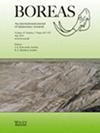在过去6.3 ka中,南半球西风调节了法格纳诺湖(阿根廷火地岛)沉积物层状的形成
IF 2.9
3区 地球科学
Q2 GEOGRAPHY, PHYSICAL
引用次数: 0
摘要
阿根廷的火地岛是研究过去全新世风变化的一个独特地点,因为它与南半球西风(SHWW)的核心相交。西南副风是地球上最强大的盛行风。它们的变化在今天和过去调节大气二氧化碳水平、降雨量和分布方面发挥着作用。我们从Bahía Grande(火地岛最大湖泊Lago Fagnano南缘的一个受保护的次盆地)获得了一个活塞核心(LF06‐PC8)。本文主要研究该岩心最上层185 cm处,对应于最近~6.3 ka的层状沉积。层压片由毫米级成对的暗层和亮层组成。以往的研究和新的地球化学分析表明,暗层和亮层的特征是锰和铁的浓度不同。我们将Mn和Fe的分布归因于偶发性低血氧-缺氧变化。年龄模型表明,每一层对形成的时间尺度近似为双年代际。我们提出了一个新的氧化还原变化模型。最可能产生水柱完全混合的现象是温压不稳定,这种不稳定发生在较冷的冬季,伴有低强度的大水波(El Niño - like条件)。相比之下,多风的冬天的特点是温度更高,水柱中的混合减少,促进氧气浓度的下降。层压和推断的周期性低铁离子氧化还原变化是过去~6.3 ka的共同特征。地球化学代理变率与El Niño/南方涛动在过去~ 2ka期间的强化相一致。本文章由计算机程序翻译,如有差异,请以英文原文为准。
Southern Hemisphere Westerly Winds have modulated the formation of laminations in sediments in Lago Fagnano (Tierra del Fuego, Argentina) over the past 6.3 ka
Tierra del Fuego in Argentina is a unique location to examine past Holocene wind variability since it intersects the core of the Southern Hemisphere Westerly Winds (SHWW). The SHWW are the most powerful prevailing winds on Earth. Their variation plays a role in regulating atmospheric CO2 levels and rainfall amounts and distribution, both today and in the past. We obtained a piston core (LF06‐PC8) from Bahía Grande, a protected sub‐basin at the southern margin of Lago Fagnano, the largest lake in Tierra del Fuego. This article focuses on the uppermost 185 cm of this core, corresponding to laminated sediment from the last ~6.3 ka. Laminations consist of millimetre‐scale paired dark and light layers. Previous studies and new geochemical analysis show that the dark and light layers are characterized by differing concentrations of Mn and Fe. We attribute the distribution of Mn and Fe to episodic hypolimnic oxic–anoxic variations. The age model suggests an approximately bidecadal timescale for the formation of each layer pair. We propose a new model of these redox changes with the SHWW variations. The most likely phenomenon to produce complete water‐column mixing is thermobaric instability, which occurs in colder winters with low‐intensity SHWW (El Niño‐like conditions). In contrast, windier winters are characterized by higher temperatures and reduced mixing in the water column, facilitating a decline in oxygen concentration. Laminations, and the inferred presence of periodic hypolimnion redox changes, are common features of the past ~6.3 ka. Geochemical proxy variability is compatible with an intensification of El Niño/Southern Oscillation activity during the past ~2 ka.
求助全文
通过发布文献求助,成功后即可免费获取论文全文。
去求助
来源期刊

Boreas
地学-地球科学综合
CiteScore
5.90
自引率
4.50%
发文量
36
审稿时长
>12 weeks
期刊介绍:
Boreas has been published since 1972. Articles of wide international interest from all branches of Quaternary research are published. Biological as well as non-biological aspects of the Quaternary environment, in both glaciated and non-glaciated areas, are dealt with: Climate, shore displacement, glacial features, landforms, sediments, organisms and their habitat, and stratigraphical and chronological relationships.
Anticipated international interest, at least within a continent or a considerable part of it, is a main criterion for the acceptance of papers. Besides articles, short items like discussion contributions and book reviews are published.
 求助内容:
求助内容: 应助结果提醒方式:
应助结果提醒方式:


